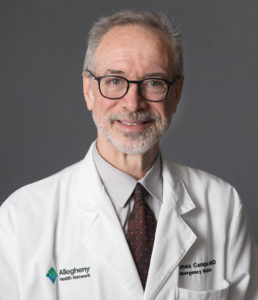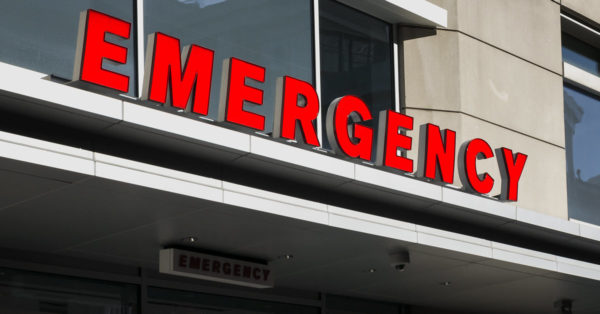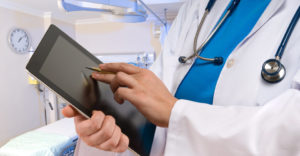When we think about our community, some common images come to mind. Neighborhood streets, parks, schools, shops, and restaurants all give a community its individual style and strength. With a little more thought, we might add a hospital to our list, grateful for the peace of mind it provides.
“To me, that’s the most important thing about emergency medicine — its ties to the community,” says Thomas Campbell, MD, MPH, the system chairman of emergency medicine for Allegheny Health Network (AHN). “It’s so important for communities to have an emergency department they can rely on, because they’re a safety net. They’re there 24 hours a day for your health and safety.”
If “emergency department” conjures unpleasant images like overcrowded waiting rooms, Dr. Campbell and AHN are working to change that. To cite just one improvement, average wait time at AHN emergency rooms is now around 12 minutes, far below the national average of 30 minutes.
Based at Allegheny General Hospital, Dr. Campbell oversees all of AHN’s emergency departments. As we discussed emergency medicine, he emphasized that every community has its own needs — one reason he believes strongly in the community-based approach to health care pursued by AHN and Highmark Health.
Corey Florindi (CF): You oversee every emergency department throughout AHN. Is there such a thing as a typical day for you and your staff?

Dr. Thomas Campbell (TC): No. That’s what I like most about emergency medicine. It also varies from one emergency department to the next. Just within our network, Allegheny General is one of only two Level 1 Trauma Centers in the entire region, and they also see a high volume of patients, and care that’s unique to them, such as transplant patients and other high-end, complicated cases. West Penn has a real community feel to it and their focus on women’s health care. Canonsburg’s emergency department has lower volume — as more of a medical and surgical facility, it’s well equipped to serve the immediate needs of that community, but it may not have all the subspecialty care and technology you see at Allegheny General. Then there are tertiary community centers like Jefferson Regional and Forbes that are truly the emergency departments in their communities — each sees close to 50,000 visitors a year.
A central goal of the Highmark Health and AHN strategy is to bring more medicine to the communities, not make people leave their communities and travel to the city for health care. That’s especially important for emergency medicine — you don’t want to travel far when you have something wrong. Having an emergency department in the community, your first stop is conveniently close — and then that ER doctor can decide if your situation can be managed there or if you need to be taken somewhere like Allegheny General that has more specialization.
CF: It’s interesting to hear you describe emergency departments as part of a community, and having their own identity — many people may not think about them that way. What other misconceptions about emergency departments do people have?
TC: One misconception is that you can only go for the most critical problems. In reality, if you’re dealing with a problem at 2 a.m., we may be the only ones available in your area. We are that entity you can go to 24/7. That’s part of our role in the community, and so emergency medicine isn’t just critical care, it’s whole care. We can also help you to identify a physician practice to establish a primary care home for all of your care and help prevent you from becoming ill.
On the other side, people sometimes expect that because it’s the emergency room, they should be seen immediately, or they get upset if they’re waiting and we take someone who came in after them. But we don’t see people by taking a number, like in a deli — we take care of the sickest people first.

We’re doing what we can to ease that frustration though. For example, at places with busier volumes, like Allegheny General, we have a Physicians in Triage process. During our busiest times, we place a physician or physician’s assistant in the triage area with a nurse to begin care, or even provide full treatment, before they even get inside the main care area of the emergency room.
CF: Are there misconceptions regarding what today’s emergency department is like? Many folks may not want to go to an emergency room because they think it’ll be chaotic, with injured people all over.
TC: Well, I’d be worried if people actively wanted to go to any emergency room. But, in seriousness, we’ve made many changes focusing on patient experience that help offset that horrible waiting room image some people might have in mind.
Rapid Registration is a good example. We now need just three pieces of information to log someone in, and then we’ll do the full registration after the patient has been triaged. With electronic medical records, if you have been to an emergency department before and haven’t changed your insurance, it may be as simple as a staff member showing you a computer screen and asking you to confirm your information. That’s the way it should be!
CF: Have there been any changes to who you see coming into emergency departments?
TC: Two changes in our region — the rise of urgent care centers and the availability of same-day appointments — have meant that folks with less serious issues (low-acuity patients) aren’t coming to hospitals as much. Low-acuity patient volume decreased about 4 or 5 percent across AHN emergency departments about the time we introduced Same-Day Appointments. So, sicker people still come to the emergency department where they can get immediate attention, but those who aren’t as sick are now receiving quicker treatment elsewhere. In the bigger picture, this is what we want — it’s a good thing.
Another factor is that our population is getting older. The end of life requires more medical care, so, despite the drop in low-acuity patients, the overall number of patients admitted to our emergency rooms has increased.
CF: Does the increase in older patients change what you need to prepare for?
TC: Sure. We’re seeing more people who have multisystem problems, and we’re seeing tons of falls with significant injury, so the trauma and emergency departments have changed to keep up with that.
Another impact — many seniors try to stay in their own homes as long as they can, and probably too long in some cases. They’re not getting their basic needs met, and then they end up in the emergency department. We have resources to help connect the elderly to assistance, but it can take time to convince someone that they might need more care than they’re willing to accept. Unfortunately, that’s one resource we tend to be short on: time. But we can at least channel people in the right direction, whether that means home service, a personal care home, or a nursing home.
CF: What are the other main challenges in emergency medicine right now?
TC: A big one across the country is overcrowding — we have fewer emergency departments due to hospitals closing, and yet more people coming to emergency departments.
Another challenge is the opioid crisis and issues with addiction. We want patients to have their pain treated, but emergency departments can also unfortunately become places where addicts go to find pain medication. With Pennsylvania’s Prescription Drug Monitoring Program (PDMP), we can now log in and see how often the patient has received pain medications, so that’s helpful.
Again, as an emergency department, we’re part of a safety net. We take care of anyone who walks in. For that reason, we see some of the issues in our own community, such as homelessness, those who don’t have access to health insurance, and folks who don’t know that there are programs to help them. There’s also the psychiatric issue. Hospitals are experiencing a shortage of psychiatric care across the country, so unfortunately there are people who probably need more psychiatric care than is available.
CF: You said earlier that emergency medicine isn’t just critical care, it’s whole care. When you were discussing seniors, it sounded like that could require interdepartmental cooperation, or coordination with outside programs — and that would be true again for community problems like addiction or homelessness. Will the emergency department of the future need to collaborate more and more with other parts of the care system?
TC: Well, let’s look at an area where it’s already very collaborative; the integration of the emergency department with pre-hospital providers is a great advancement, and it’s evolving even more with technology. Pre-hospital providers now use cameras to show the emergency department doctor exactly what the situation looks like. That allows us to be better prepared when they arrive at the hospital. It also means that sometimes paramedics can carry out treatment at the scene without bringing the patient in at all. Pre-hospital providers can’t practice without physician oversight, but we now have the technology to make that happen in many cases. Maybe someone called 911, the ambulance arrives, but we’re able to determine that it’s a diabetic with a low blood sugar; the EMTs can treat that, saving that patient a trip to the hospital.
CF: How else do you see emergency medicine evolving in the future?

TC: Technology — I’m excited about how we can use new equipment and software. “Tele” anything is huge. The paramedic example above, being able to help someone while they’re still at home — that’s definitely the future.
We’ll also see more biotechnology issues — pacemakers, insulin pumps, and things like that. More wearable or implantable biotechnology is the wave of the future, and the emergency department will be a part of how that looks.
Technology will also continue shaping who we see, or don’t see, coming to emergency rooms. Think about the classic dilemma: “Am I sick enough to go to the emergency room, or should I wait to see my PCP, or can an urgent care clinic help?” How do you make that decision? In the past, some people went to the ER who didn’t need to, and others sadly didn’t go when they should have. Now, you have things like Highmark’s Blues On Call program. I’ve been a big proponent of this system since its start. When Highmark health plan members call in, they’re talking to a clinically trained nurse who knows what questions to ask and can advise whether to go see a PCP, visit an urgent care facility, or get to an emergency department.
Getting back to the importance of community-based care, I think we’ll see more of what we’re doing in the joint venture between AHN and Emerus: building new microhospitals where they’re needed so people don’t have to drive long distances for certain types of care, including basic emergency care.
If we can direct people to the right place from the beginning, health care becomes more cost-efficient and time-efficient for the patient and we make sure everyone gets the right level of care. Any technology or investment that allows us to do that, including informational services like Blues on Call, is part of evolving to better serve our communities.